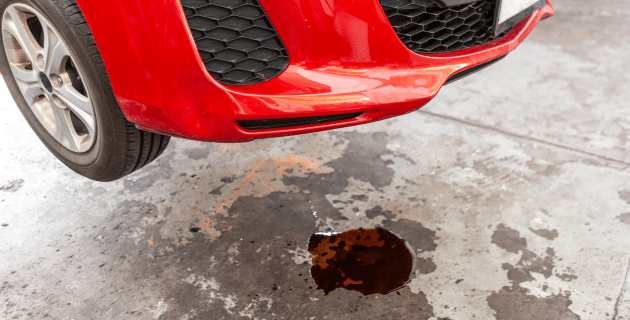There’s a puddle underneath your car. Don’t panic. If it’s summer and you’ve just run the air conditioning, you probably don’t need to worry. But there are times when you should be concerned.
We’ve put together a guide to why puddles form under cars, what to look for, and when you need to act.
What is an air conditioning puddle?
Water puddles are common on hot, humid days after we run our car’s air conditioner. That’s because the process of air conditioning produces condensation. There’s a drain tube built into the system that allows that moisture to pass through the floorboard and exit the car. You’ll usually see that puddle under the car on the front passenger side.
Note: A puddle under the car is normal. A puddle inside the car is not.
Check to see if the puddle is water.
Chances are, if it’s a hot day and you just ran the air conditioning, that puddle is water. However, you can easily check that.
- Dip a clean rag in the puddle. Do the sniff test. If there’s an odor, it’s not water.
- Visually inspect the fluid on the rag. If there’s a color, it’s not water.
- Slide some white cardboard under the car to tell what is leaking and where.
What if it’s not water?
If it’s not water, here are some common fluids that could be leaking from your car. Should you see any of these leaks, get them fixed as soon as possible.
- Coolant (antifreeze) – Coolant comes in many colors, including green, orange, yellow, blue, greenish blue, pink or red. It may appear clear with a hint of color. It also will have an odor. If your radiator loses too much coolant, your engine can overheat. Leaks also are dangerous to pets. The sweet smell of coolant can attract them and it’s poisonous if consumed.
- Gas – A fuel leak may look like water, but it will smell like fuel. It’s also highly flammable so be cautious when handling it. Fuel leaks usually happen due to a crack in the fuel tank.
- Oil – If it’s light brown or black, and greasy, it’s probably engine oil. You’ll find this type of leak at the front end of your vehicle. If you suspect an oil leak, check your car’s dipstick. If it’s low, that confirms there is an oil leak.
- Brake fluid – This type of fluid ranges from clear to yellow brow in color. You’ll find the leak near the wheels. It’s not safe to drive if you have a brake fluid leak. It may cause the brakes to fail.
- Automatic transmission fluid – This fluid is pink to dark brown. It is a lubricant and a coolant. If you have this type of leak, driving your car could cause further damage.
- Power steering fluid – Usually yellow or reddish brown in color, a power steering fluid leak will have a slightly sweet, burnt smell. Driving on low levels of steering fluid can cause lasting damage.
- Windshield washer fluid – This comes in colors such as blue, purple, green, or orange. You’ll likely find the leak in the reservoir near the windshield. While a windshield washer fluid link won’t affect the car’s operation, it will impact your ability to drive in the rain.
Refrigerant Leaks
There’s also a possibility that the refrigerant from your air conditioning system is leaking. Refrigerant is colorless and can look like water. If refrigerant is leaking, it puts a strain on the compressor and reduces the air conditioner’s ability to cool down air.
Leaks can happen for a variety of reasons. These include a blockage in the drainpipe, the drain not being attached properly, air filters that are dirty or blocked or a broken drain pan.
Here’s how to diagnose a refrigerant leak:
- Listen for a clicking sound. With less refrigerant, the compressor shortens its cycle. This creates a clicking sound, which is an early warning sign.
- Look for a dashboard When refrigerant levels are low, there may be an early warning light.
- The air conditioning stops working. If it’s blowing hot air, the refrigerant level is too low.
Air conditioning leaks inside the car
If your air conditioning drain tube becomes blocked, you may notice a buildup of water on the front carpets and mats of your car. That may mean you need to clean out the tube and remove any debris. This will allow condensation to flow freely. If the tube is deteriorating or damaged, or if the heater core is leaking, it requires a more extensive repair. If you suspect a clogged drain tube, try driving without the air conditioning. See if the dampness continues. If it does not, then you’ll want to get your drain tube checked out.
Your car is one of your greatest investments. Keep it well maintained and fully insured for added peace of mind. Safe travels.
This article is furnished by California Casualty, providing auto and home insurance to educators, law enforcement officers, firefighters, and nurses. Get a quote at 1.866.704.8614 or www.calcas.com.
- California Casualty Earns Financial Stability Rating® of A, Exceptional, From Demotech, Inc. - April 28, 2025
- Music & Arts Grant Recipients – 2024 - December 13, 2024
- Understanding Auto and Home Insurance Rate Changes - December 3, 2024

